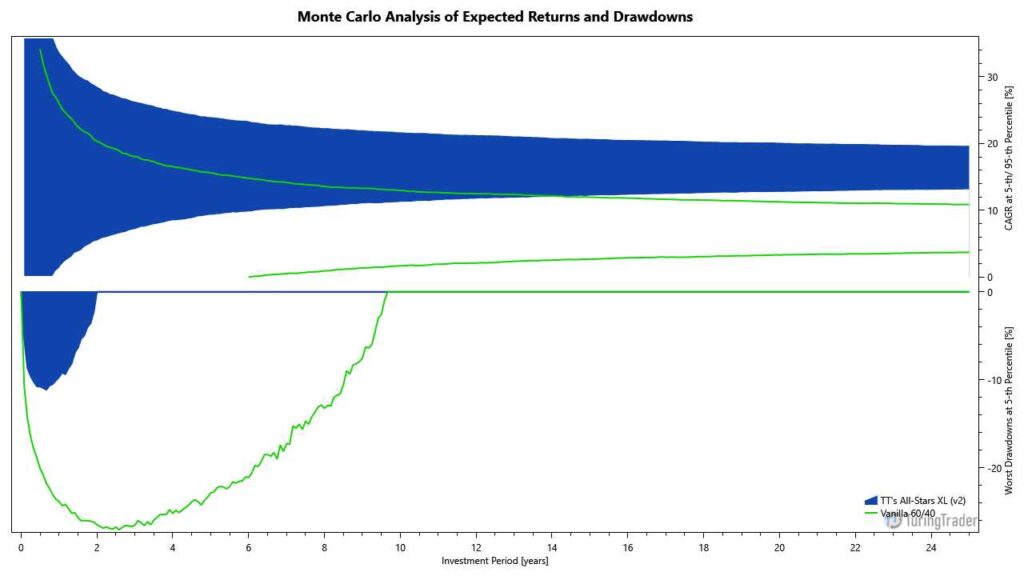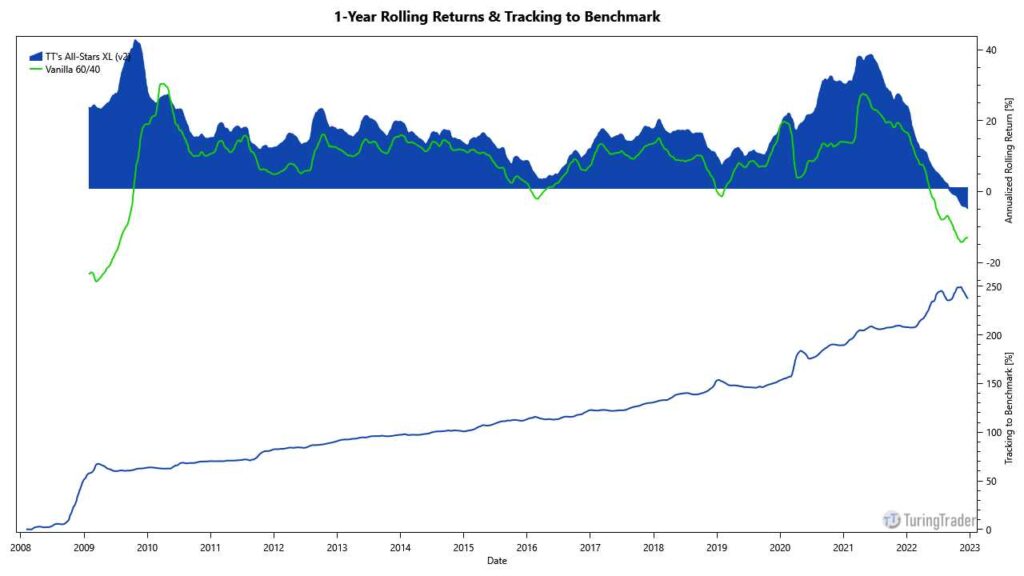Summary
- Objective: balanced growth
- Type: momentum strategy
- Invests in: ETFs tracking equities, fixed income, hard assets
- Rebalancing schedule: monthly
- Taxation: 80% short-term capital gains
- Minimum account size: $10,000
Wouter J. Keller is a researcher at the VU University Amsterdam and the CEO of Flex Capital, an asset management firm based in the Netherlands. Together with Jan Willem Keuning, he published his Defensive Asset Allocation (DAA) in a paper released in mid-2018.
Keller’s Defensive Asset Allocation aims to provide a healthy, diversified asset allocation, with protection against sudden market downturns. To achieve this goal, the strategy combines relative momentum with a unique canary universe to determine the need for portfolio crash protection.
DAA rebalances once per month, making the strategy low maintenance.
Performance
This table shows the portfolio’s key performance metrics over the course of the simulation:
The following chart shows the portfolio’s historical performance and drawdowns, compared to their benchmark, throughout the simulation:
This chart shows the portfolio’s annual returns:
The following charts show the Monte-Carlo simulation of returns and drawdowns, the portfolios 12-months rolling returns, and how the portfolio is tracking to its benchmark:


Asset Allocation
The portfolio last required rebalancing after the exchanges closed on @last-rebal@. Due to fluctuations in asset prices, the exact allocations vary daily, even when no rebalancing occurred. The current asset allocation is as follows:
Sign up for our FREE Basic membership to see the asset allocation.
Sign up for our FREE 14-day trial to see the asset allocation.
Strategy Rules
Keller’s Defensive Asset Allocation exists in multiple flavors which differ in the composition of their universes. Our implementation of Keller’s strategy is true to the publication’s DAA-G12 variant. The strategy’s operation can be summarized as follows:
- trade a universe of
- twelve risky assets covering U.S. and international equities, hard assets, long-term treasuries, corporate bonds, and high-yield bonds
- three cash assets including U.S. treasury bonds and investment-grade corporate bonds
- determine cash fraction from number of assets with negative momentum within canary universe
- allocate capital to up to six risky assets, ranked by momentum and depending on cash fraction
- allocate remaining capital to the top-ranking cash asset
For full detail and the rationale behind Defensive Asset Allocation refer to Keller’s detailed paper. Further, the C# source code for the strategy is included in the TuringTrader.org open-source project repository.
We like Keller’s concept of controlling exposure to risky assets a lot, as it reflects the notion of risky assets often increasing their correlation in times of crisis. However, as the DAA-G12 variant’s canary universe contains only two assets, the strategy transitions into cash assets rather abruptly. Further, we are not fully convinced that the breadth of this narrow canary universe will always be a good indicator of market stress.
Diversification
Keller’s method of distinguishing risky and cash assets, combined with the broad menu of asset classes ensures that the strategy is, in times of market stress, well diversified across asset classes. This is confirmed by the _Defensive Asset Allocation’s low beta, as well as its meek characteristics in 2008, 2015, and 2020.
However, it is worth pointing out that in seemingly calm and bullish periods, the strategy may have 100% exposure to a single asset class, even though across multiple markets. This leads to some tail risk, should markets shift faster than the strategy’s canary universe.
Returns & Volatility
Overall the Defensive Asset Allocation shows very docile behavior with steady returns over the last economic cycle: Not only has DAA gracefully handled the 2008 recession, but it also excelled during the 2009 rebound.
Compared to other momentum strategies, DAA‘s performance during the shifting markets of 2016 and 2018 trailed that of passive portfolios by a much lesser degree. DAA‘s method of selecting the cash asset with the highest momentum seems to help to reduce the drag on overall performance this asset class has on many other portfolios.
The Monte-Carlo simulation shows that Keller’s strategy has clear value: Statistically, it successfully increases returns and reduces maximum drawdown. However, maximum drawdowns might be significantly higher than the backtest suggests, given that the backtest’s drawdown ranks in a very low percentile.
Account & Tax Considerations
Just like other strategies rotating assets, this strategy frequently causes taxable events. The chart above shows, that investors cannot expect Defensive Asset Allocation to hold any asset long enough to qualify for long term treatment of capital gains. Consequently, DAA works best in tax-deferred accounts.
Keller’s strategy invests in up to 7 ETFs simultaneously. Therefore, it requires an account size of no less than $10,000 to function correctly.
